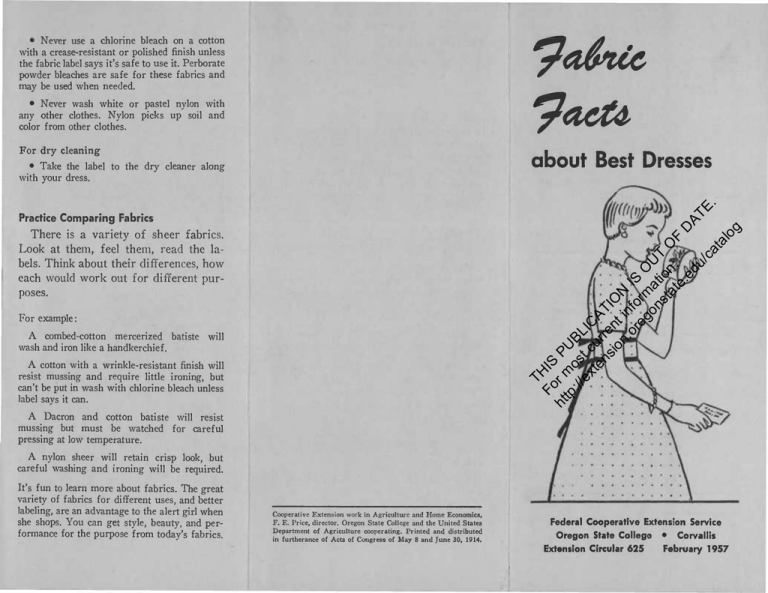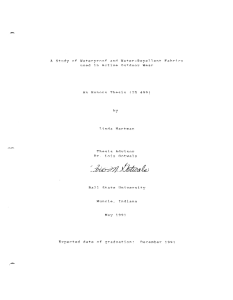• Never use a chlorine bleach on a cotton
advertisement

• Never use a chlorine bleach on a cotton with a crease-resistant or polished finish unless the fabric label says it's safe to use it. Perborate powder bleaches are safe for these fabrics and may be used when needed. • Never wash white or pastel nylon with any other clothes. Nylon picks up soil and color from other clothes. For dry cleaning about Best Dresses T Fo HIS ht r m P U tp :// os BL ex t c IC te ur A ns re TI io nt ON n. in or fo IS eg rm O on at U st ion T O at : F e. D ed AT u/ E. ca ta lo g • Take the label to the dry cleaner along with your dress. Practice Comparing Fabrics There is a variety of sheer fabrics. Look at them, feel them, read the labels. Think about their differences, how each would work out for different purposes. For example: A combed-cotton mercerized batiste will wash and iron like a handkerchief. A cotton with a wrinkle-resistant finish will resist mussing and require little ironing, but can't be put in wash with chlorine bleach unless label says it can. A Dacron and cotton batiste will resist mussing but must be watched for careful pressing at low temperature. A nylon sheer will retain crisp look, but careful washing and ironing will be required. It's fun to learn more about fabrics. The great variety of fabrics for different uses, and better labeling, are an advantage to the alert girl when she shops. You can get style, beauty, and performance for the purpose from today's fabrics. Cooperative Extension work in Agriculture and Home Economics, F. E. Price, director. Oregon State College and the United States Department of Agriculture cooperating. Printed and distributed in furtherance of Acts of Congress of May 8 and June 30, 1914. Federal Cooperative Extension Service Oregon State College • Corvallis Extension Circular 625 February 1957 Fabric keys the personality and mood of your dress. Get the right one for you and your purpose. You'll like your best dress longer if, before you buy, you Fashions in Fabrics In spring and summer you'll see color, interesting texture, and lightweight softness in fabrics. Think: What you want Wants -|- Needs + Care - = Value Price This is an example of decisions one girl made before buying a dress. Wants U/atd a bed JUeM,. Needs fi/eed jjosi Apeclal Accaiioni MOW-, W^OA, .^ Ackool Mztesi. £keeA, xmd cotton Acdm xu^ Jwaadcloik xzne Color Lavender and violet tones predominate—but pinks, greens, blues, and beige and yellow tones also are good. Fabrics are found in coordinated colors— beautiful blendings of prints, stripes, and plaids with plains. A wonderful way to express your personality in color. T Fo HIS ht r m P U tp :// os BL ex t c IC te ur A ns re TI io nt ON n. in or fo IS eg rm O on at U st ion T O at : F e. D ed AT u/ E. ca ta lo g What you need Texture Color variations and weave variations make interesting texture effects. New and popular are satin stripes and leno weave stripes on woven cottons—open weaves that are airy in color and weight—many sheers. • Dacron resists mussing when worn but does not absorb moisture. It is more comfortable when combined with cotton. Nylon, Orion, and acetate also add crease resistance to a blend but may feel uncomfortably warm when used alone in a fabric. • Mercerized and combed cotton on the label mean more luster and added strength. Save the Label Lightweight softness Ladylike fabrics for ladylike look—soft, silky cottons—cotton and silk blends. All-silk dresses, some machine washable, some hand washable, some dry cleanable only—follow the label. Rayons and acetates with finer silkier look. Chiffon weight corduroys. For pressing • Use low setting for pressing fabric made of or containing any nylon, Dacron, or acetate. These fibers melt and stiffen under a medium or hot iron. Use low setting for pressing Orion or Acrilan to prevent yellowing. If you sew, learn how to handle softer fabrics and softer-styled patterns. • Use medium heat for ironing or pressing rayon and Arnel dresses. Fabric Facts Care • Vat dyes are the best dyes. They are used on cottons and rayons. Rayons can be solution dyed for fast color. Coloray is an example. Acetates can be solution dyed for fast color. Some examples are Chromspun, Celaperm, Color Sealed Acetate. Unless solution dyed, acetates may change shades from the action of the gases in the atmosphere. Gas stoves, gas heat, and ozone from electric storms can cause gas or fume fading of acetate. • Polished cottons have been given a special finish for a durable, polished, lustrous look. The weave gives luster to cotton satin. This luster may be increased by special chemical finish. The satin holds the luster well and drapes into soft folds. For washing • Follow any specific directions given on the tag. • Remove, before washing, any oil or greasy stains if the fabric has a crush-resistant finish or if the fabric is made of nylon, Dacron, Orion, or acetate. T Fo HIS ht r m P U tp :// os BL ex t c IC te ur A ns re TI io nt ON n. in or fo IS eg rm O on at U st ion T O at : F e. D ed AT u/ E. ca ta lo g





